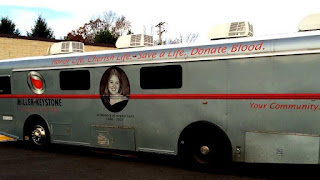A bloodmobile is a mobile blood donation center. It is a vehicle (usually a bus or a large van) equipped with everything necessary for a blood donation procedure. Blood drives involving bloodmobiles usually happen in public places such as colleges and churches.
Often large employers will sponsor mobile blood drives and allow employees a few hours off of work to donate blood. In addition, many high schools hold annual blood drives which allow students aged 16 and over to donate blood with a signed permission form. Typically students are offered snacks, T-shirts, or time out of class as an incentive, as well as positive peer pressure.
Video Bloodmobile
How to Organise a Blood drive
The first step in organising any blood drive is to contact the nearest blood bank or blood donation centre and a blood drive representative is assigned to help the person organising the blood drive. The Representative will make the assessment for if the Organising Company meets the requirements for the drive to go ahead. Once the Representative gives the "okay" the Representative and Organiser plans the actual drive together, establishing mutual goals for the drive, based on the size of the group and how many people are expected to donate. As well as of agreeing and setting a date and time for the drive to go ahead.
Maps Bloodmobile
How a Bloodmobile worked in the 1950's
In The 1950s the American Red Cross would run mobile blood units that would pop up all over the place giving people a location that is community based to generously donate.
In the 1950s these mobile blood units were very efficient, with a large Red Cross truck Manned only by two men, arriving at an empty location and setting up for the first donation which would be taken only two hours later. The Truck would be loaded with at least ten beds, mattresses, dozens of screens and chairs, waste receptacles, tables, stools, huge refrigerated boxes, can-vas bags of ice, coffee urns, gallons of orange juice, buckets, canteen equipment, Hundreds of blood bottles, boxes of sterile supplies, bottles of solution, literature and record forms, oxygen tanks, and sheets only to which the men would have unloaded and set up on site in less than 1 hour. Once set up is complete nurses, volunteers and Doctors Arrive on site to get dressed into uniforms. There were normally 6 nurses and 15 volunteers, the Nurses would do their preliminary task while the volunteers would split off into groups. One group would unpack and set up the reception ready to record details of some 200 donors over 6 hours. Another group would set up the canteen can prepare food for after donations. The third group will set up the blood bottle table where the blood would be tagged numbered and recorded. From there the site has now been set up ready to take donations.
When the site is open donors would enter via the reception to answer questionnaires which determine if the donor was eligible to donate. Once the donor was accepted they were taken through to the nurse who would take blood pressure and perform other various tests. Once the donor had undergone those test they would be passed on to next nurse where the blood was taken. If the donor had a reaction while donating they went to the recovery room where they went under the care of the doctor until they had fully recovered. If the donor did not have a reaction they would go to the canteen where they were welcome to refreshments for donating.
In the 1950s Mobile Blood units like this would collect from 200 donors in a 6-hour collection.
Gallery
See also
- American Red Cross
- Blood Bank
- Phlebotomy
References
External links
- Information from bloodmobile.org
- Definition from Merriam-Webster online
Source of article : Wikipedia

